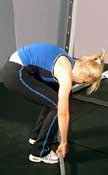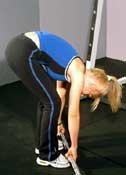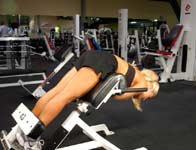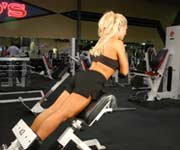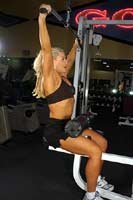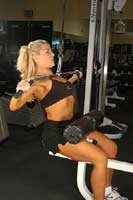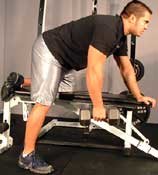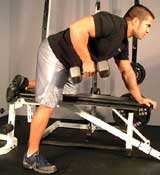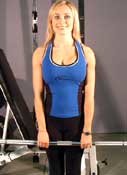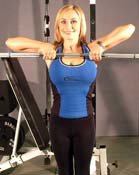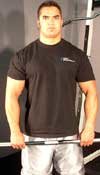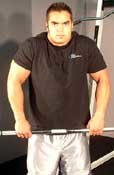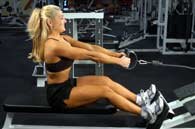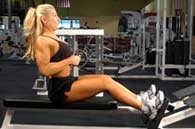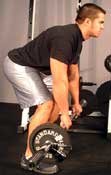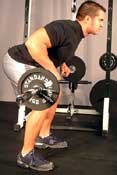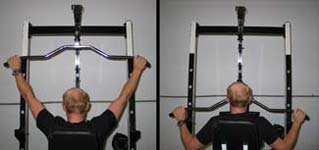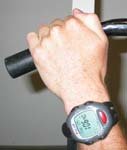Neglecting some muscles while over-working others can be devastating to muscular potential and quality of life. Serious strength imbalances and improper muscle firing patterns from this kind of training can cause vertebral abnormalities, and will ultimately lead to injury. To remedy a physique imbalance, one must employ the use of the priority principle.
The priority principle necessitates identifying weak or underdeveloped body parts, and then dictates training weak body parts first when the athlete is fresh, using low-volume, heavy compound movements, to stimulate maximum growth.
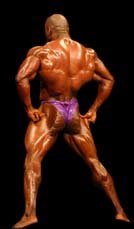 To this end, the following training split is ideal for working the back for best results.
To this end, the following training split is ideal for working the back for best results.
-
Day 1: Back, trapezius
Day 2: Legs, forearms
Day 3: Off
Day 4: Deltoids, triceps
Day 5: Chest, biceps
Day 6: Off
Day 7: Off
The above split places back training on day one, after a two day hiatus for recovery. If your back requires development, always work back first and trapezius last on this training day.
Stimulating a muscle for hypertrophy is only part of the solution. To add maximum size to your back most efficiently, the variables of exercise selection, intensity and nutrition must be manipulated. Nutrition is included here because stimulus manipulation alone is futile unless the nutritional supply can meet the demand imposed upon the body by the said stimulus.
The back development program outlined here has been designed with maximum growth in mind. It is comprised of compound and auxiliary exercises, and is to be executed in an alternative fashion. One week program A will be used, and the following week program B.

The Exercises

1. Deadlifts - View Exercise
-
Deadlifts should be a staple exercise for all bodybuilders, even if their back is well developed. Aside from being an excellent strength exercise and back builder, deadlifts stimulate anabolic hormone release by simultaneously working numerous muscle groups.
The deadlift is commonly thought to be only a back exercise, but if performed correctly it also stimulates the gluteus, the hamstrings, quadriceps, abdominals, trapezius, deltoids, lats and erectors. The deadlift is a total-body movement.
To perform this exercise, adopt a foot stance slightly greater than shoulder-width apart, bend the knees and take an overhand grip on the barbell. Making the conscious effort to keep the lower back straight, the glutes firing, and the head looking forward, rest on the heels of your feet. To do this correctly, the hips and buttocks should be sufficiently close to the ground.
What NOT To Do:
Driving the bar up to thigh level, fire the glutes, hamstrings, quadriceps and abdominals. With the shoulder blades back and retracted, pause at the top of the movement, contracting the abdominals, and being sure to keep the lower back straight but not hyper extended.
Under control lower the barbell to the starting position and repeat the movement for the sets and repetitions specified.
2. Hyperextensions - View Exercise
-
Despite the name of this movement, one should be careful to not hyperextend the low back - only to flex it slightly.
Keeping the sight of vision vertical to the floor, use the erectors to move the body through space. At the top of the movement, slightly flex the lower back. Keeping ones eyes vertical to the floor is crucial to prevent hyper extending the neck. Be sure to also stay tight in the core muscles throughout the movement.
3. Wide-Grip Pulldowns - View Exercise
-
More than any other exercise for the back, wide-grip pull downs are done incorrectly by the majority of trainees. The most common mistakes include doing this movement behind the neck, pulling with the arms instead of the lats, and leaning too far back when pulling to the front, in order to cheat.
The first mistake - pulling the weight behind the neck instead of to the front - can lead to inflammation of the supraspinatus. This can result in upper back and neck problems.
Pulling with the arms instead of the lats will deprive the lats of stimulus, thus making the movement useless. The key to avoiding this mistake is to reduce the amount of weight being used, and to eliminate the involvement of the forearms by placing the thumbs at the side of the index fingers. This will force the arms to function as hooks only, and will transfer the weight load to the lats.
Also of importance is form and neck position. Form should be perfectly tight and controlled, and one should maintain an erect posture. Keeping the neck in an upright position will ensure that the center of gravity remains ideal for working the lats. At the bottom of the movement try using an "elbow push" to squeeze the lats for additional development.
4. One-Arm Dumbbell Rows - View Exercise
-
Dumbbell rows will build tremendous thickness, but only if done correctly.
The most common errors include using too much weight, failing to maintain tightness in the core muscles, and failing to keep the shoulder parallel to the ground. Often, the last two mistakes result from the first.
Failing to contract the core muscles will lead to a decreased ability to maintain proper posture, which will put the scapulae in a vulnerable position. If the shoulder blade is drawn toward the ground, inflammation of the supraspinatus can result, and this is why trainees often complain of shoulder blade pain resulting from this movement.
For this exercise, pick a weight that allows you to feel the muscle contract while also maintaining strict form. Keep the lower back straight and the neck in the eyes-forward position. Keep the shoulder blade still, and row with the latisimus dorsi muscle, using an "elbow push" at the top of the movement for extra stimulation and growth.
5. Upright Barbell Rows - View Exercise
-
Upright barbell rows are an excellent trapezius exercise that will also work the deltoids.
Contrary to popular practice, it is not always necessary to use a lot of weight to achieve the desired result. If one uses too much weight, other muscle groups will fire to compensate for trapezius weakness.
I have seen countless trainees who use too much weight, only to involve the calf muscles in an attempt to hoist the weight up because the trapezius muscles are unable to handle an excessive load. Poor form is a dangerous habit to fall into because if reinforced through repetition, abnormal firing patterns will become regular practice and strength imbalances will occur.
Using a barbell and taking an overhand grip greater than shoulder width, pull the bar toward the neck, while keeping it close to the body. Avoid using momentum to move the bar through space. Momentum will cause abnormal movement of the spine and will shift the center of gravity, putting you at risk for injury.
By bringing the bar to neck level, the deltoids will disengage and the trapezius will contract. Lowering the bar under control will pull on the trapezius and will allow them to lengthen against resistance.
6. Barbell Shrugs - View Exercise
-
Maintaining proper posture and form for this exercise is crucial. Taking an Olympic barbell with a slightly greater than shoulder width overhand grip, shrug the weight up by bringing the deltoids to the ears in a straight up and down movement. Do not bounce the bar at any time during the exercise.
Keep the shoulder blades down and back during this movement by contracting the abdominals. Avoid the temptation to change the center of gravity by pushing the neck forward at the top of the movement (at the maximum concentration point). Keep the eyes looking forward at all times.
7. One Arm Seated Rows - View Exercise*
-
Like the two-handed cable rows that develop thickness in the middle of the back near the spine, one arm seated cable rows do the same, one side at a time. In fact, one arm seated cable rows are useful for developing pull power on each side of the body and for correcting any strength deficiencies that may exist.
Taking a single-handed handle and selecting the appropriate amount of weight, contract the abdominals, and pull with the appropriate latisimus dorsi muscle. Use light weight for this movement and allow the scapulae to move within its natural range of motion. Bring the arm to full extension and then full contraction, pushing the elbow back fully, squeezing the latisimus dorsi muscle.
* Shown with both hands.
8. Barbell Rows - View Exercise
-
Barbell rows, like dumbbell rows, are an incredible mass builder but it is a mistake to do them on the same day as deadlifts, as the Erectors will already be fatigued from the deadlifts to provide sufficient support to stabilize the body for rowing movements.
For this exercise use an overhand grip. With the bar in hand, place the feet closer than shoulder width apart, making sure to straighten the lower back and place the eyes looking forward. With a 90 degree angle being formed at the waist, row the bar into the abdominal area.
Under control return the weight to resting position and repeat for the number of sets and repetitions specified. Use the elbow push technique to get extra stimulation in the lats. Failure to keep the neck in the proper position can lead to neck and upper back problems.
9. Partial Deadlifts In Power Rack - View Exercise
-
The advantage of a partial deadlift over the full deadlift is that it allows the body builder an opportunity to overcome sticking points in the movement, and it also allows for isolation of the lower back. What is more, a partial lift reduces the overall contribution of the hips, hamstrings, gluteus and quadriceps in the movement.
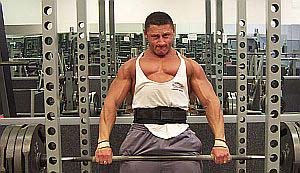
The biggest disadvantage that a partial repetition brings is that it places emphasis on the upper half of the movement, while most bodybuilders and power lifters have the most difficulty generating sufficient power at the bottom of this exercise to move the weight through the proper range of motion. This should not blind bodybuilders to the results that partial deadlifts can bring.
As with its full range cousin, the partial deadlift should be performed by taking an overhand grip on the barbell, with the lower back straight, the scapulae down and back, and the neck straight with eyes looking straight ahead.
10. Face Pulls - View Exercise
-
Face pulls are a great exercise for developing dense and strong traps.
Traditionally an auxiliary powerlifting movement, face pulls can be useful to bodybuilders, and can serve to help compound movements like the clean and press, deadlift, seated shoulder press and the flat bench press.
For this exercise, place hands in an overhand grip on a lat pulldown machine bar, making sure to inactivate the forearms by placing thumbs on the outside of the bar near the index finger. Maintaining erect posture, pull the bar to the nose and control it until it returns to the original position.
11. Dumbbell Shrugs On Knees - View Exercise
-
Dumbbell shrugs are incredibly effective at stimulating the traps, but they are seldom performed correctly.
- Hold the dumbbells in front of the body and pull back, squeezing the trapezius
- Hold the dumbbells at the side of the body, rotating the shoulders in a backward motion
- Do one of the above but also move the neck forward, changing the center of gravity and the target of the weight load
Most commonly, bodybuilders will do one or more of the following:
These are three practices or any combination thereof will lead to injury. Some will lead to injury more quickly than others, but because each is a maladaptive motor pattern, injury will be the resultant. To avoid painful injury, careful attention to proper execution of movement is critical.
Taking a kneeled position with dumbbells at the side of the body, move the shoulder blades down and back, contract the abdominals to ensure core stability, and shrug the shoulders in an up-and-down motion, squeezing at the top of the movement and letting the dumbbells hang at the bottom.
By performing this exercise in a kneeling position, it forces and proper form and eliminates the swinging motion seen typically with the standing version. It also ensures proper alignment of the spine, which will facilitate proper contraction of the target muscles.

The Program At A Glance

As indicated earlier, this program is divided into two workouts, to be done on alternating weeks according to the following outline:
Workout A
| Exercise | Sets x Reps |
| Deadlifts | 1x6 1x6 1x6 1x6 1x6 |
| Hyperextensions | 1x15* 1x15* |
| Dumbbell Rows | 1x10 1x10 1x10 |
| Wide Grip Pulldowns | 1x10 1x10 1x10 |
| Barbell Shrugs | 1x15* 1x12 1x12 1x10 |
| Upright Dumbbell Rows | 1x12 1x12 1x12 |
 Click here for a printable log of Workout A.
Click here for a printable log of Workout A.
Workout B
| Exercise | Sets x Reps |
| One-Arm Seated Rows | 1x12 1x12 1x12 |
| Barbell Rows | 1x8 1x8 1x8 |
| Partial Deadlifts In Power Rack | 1x12 1x12 1x12 |
| Face Pulls | 1x12 1x12 1x12 |
| Dumbbell Shrugs On Knees | 1x20 1x12 1x6 |
 Click here for a printable log of Workout B.
Click here for a printable log of Workout B.
As can be seen, this workout has included both pull and squeeze movements. Both are critical for back development.
Pulling movements are invaluable because they develop contractile strength, and as such stimulate endocrine sites for hormone release, thereby promoting CNS adaptation. Squeezing movements facilitate fiber stimulation and will lead to dramatic growth. When CNS adaptation has occurred, it becomes possible to progressively overload muscle tissue, forcing growth.

Conclusion

The program outlined in this publication is effective because it is consistent with currently accepted scientific practice for forcing muscular hypertrophy. With a focus on recovery, the program is designed to avoid extended periods of central nervous system depression, and glycogen deficiencies.
By applying the specified stimulus according to the prescribed manner, this program will assist you greatly in developing thickness, width and functionality to your back muscles.
 Ronnie Coleman Ronnie Coleman |
 David Henry David Henry |
 Dorian Yates Dorian Yates |
 Arnold Schwarzenegger Arnold Schwarzenegger |
 Sergio Oliva Sergio Oliva |
 Dexter Jackson Dexter Jackson |
Disclaimer
The information provided in this publication is for educational and informational purposes only and does not serve as a replacement to care provided by your own personal health care team or physician. The author does not render or provide medical advice, and no individual should make any medical decisions or change their health behavior based on information provided here.
Readers are encouraged to confirm the information contained herein with other sources. Readers and consumers should review the information in this publication carefully with their professional health care provider. The information in this or other publications authored by the writer is not intended to replace medical advice offered by physicians.
Reliance on any information provided by the author is solely at your own risk. The author does not recommend or endorse any specific tests, products, medication, procedures, opinions, or other information that may be presented in the publication. The author does not control information, advertisements, content, and articles provided by discussed third-party information suppliers.
Further, the author does not warrant or guarantee that the information contained in written publications, from him or any source is accurate or error-free. The author accepts no responsibility for materials contained in the publication that you may find offensive. You are solely responsible for viewing and/or using the material contained in the authored publications in compliance with the laws of your country of residence, and your personal conscience.
The author will not be liable for any direct, indirect, consequential, special, exemplary, or other damages arising from the use of information contained in this or other publications.
Copyright ? Clayton South, 2004 All rights reserved.
Without limiting the rights under copyright reserved above, no part of this publication may be reproduced, stored in or introduced into a retrieval system, or transmitted in any form, or by any means (electronic mechanical, photocopying, recording, or otherwise), without the prior written permission of the copyright holder and author of this publication.



